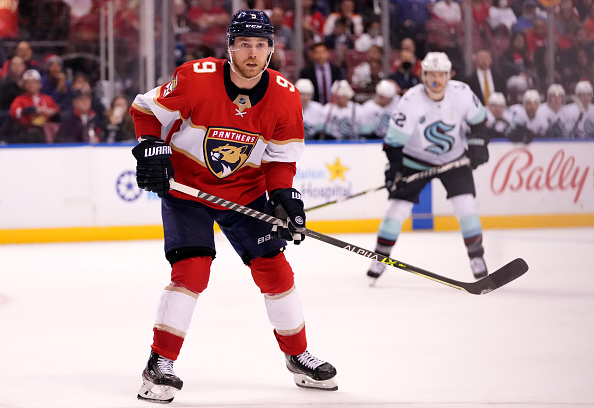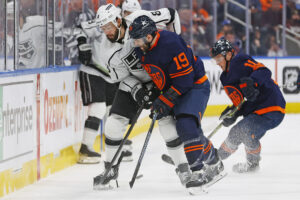Player development seems to always result in more questions than answers. How likely is it for a top pick to pan out? What makes a player a “steal”? Last Word On Hockey will be starting a new series on how to properly develop prospects from all different spots throughout the draft. This week’s piece involves top-10 picks and how they were used early in their careers.
Player Developments of Top-10 Picks
In the span of 2005 through 2015, there were 40 total selections made between fourth overall and tenth overall on forwards playing in North America. Of those 40 selections, five players were given patience in their player development. What that means is an extra year despite solid production that deemed them NHL-ready before being given a chance. Those five players were Nikolaj Ehlers, Mitch Marner, Sam Bennett, Jakub Voracek, and Derick Brassard. In this piece, we will be looking at Sam Bennett and Jakub Voracek. Last piece, we looked at Ehlers and Marner.
Player Development of Sam Bennett
Bennett, drafted fourth overall by the Calgary Flames in the 2014 NHL draft, is currently a part of the Florida Panthers organization. But before the 25-year-old became an established NHL player, let’s look at his rise. In his DY-1 season, Bennett played for the Kingston Frontenacs of the OHL for 60 games, scoring 18 goals and 22 assists for 40 points. That was good enough for a points per game pace of 0.667, ranking 31st out of 40 forwards in DY-1 production. He followed that season up with an excellent DY season, scoring 36 goals and 55 assists for 91 points in 57 games with the Frontenacs. That was a rate of 1.596 points per game, ranking eighth of those same 40 forwards in DY production.
However, that production was not enough to get him a spot with the Flames. Playing one more season with the Frontenacs went very well on the ice. However, he played just 11 games after sustaining a shoulder injury. He missed 59 games. Despite that, he scored 11 goals and 13 assists for 24 points in those 11 games after shoulder surgery. That was a pace of 2.182 per game, ranking first out of 30 forwards still not playing a role at the NHL level in DY+1 production. That was the last time he played at a level under the NHL.
How Was Bennett Used?
Playing 77 NHL games in his rookie season, Bennett scored 18 goals and had 18 assists for 36 points. That came while averaging 15:09 ice time per game, a decent role for a rookie. His advanced analytics weren’t bad, either. Bennett’s even-strength offence goals above replacement (EVO), even-strength defence goals above replacement (EVD), wins above replacement (WAR) and goals above replacement (GAR) were all above replacement level. His EVO was a solid 4.3, while his EVD was okay, at 0.2. Meanwhile, his WAR and GAR were up at 1.3 and 6.9, respectively, which is solid for a young kid.
He followed up what was a good rookie season with a sophomore slump. In 81 games with Calgary in year two, Bennett scored just 13 goals and 13 assists for 26 points, 10 points less than year one. He also averaged less ice time, dropping to 14:59 per game. That drop in ice time was not drastic, and it shouldn’t have impacted his raw stats that much, especially when playing in more games than the year before. But his advanced analytics paint a better picture. His EVD went up drastically (4.5), while his EVO dropped drastically (-2.3). Overall, however, his game regressed, as his WAR (0.3) and GAR (1.6) dropped a lot as well, despite the defensive improvements.
Bennett Continues Slight Regression Due to Poor Player Development
In his third season, Bennett would see a full 82-game NHL season. He produced just 11 goals and 15 assists for 26 points, matching his year two production, despite playing more games. Part of the issue could be another drop in average ice time, this time averaging just 14:24 per game. His advanced analytics were pretty terrible in his third season as well. His EVO was down at -2, somehow an increase from the year before. But his EVD went all the way down to -3.6. His extreme struggles in both ends, at even-strength, were pronounced in his WAR (-1.8) and GAR (-9.3) being so low.
Bennett’s final two and a half seasons with Calgary, following those first three, were not great. Playing 161 NHL games in that span with the Flames, he scored 25 goals and 26 assists for 51 points, averaging around 13 minutes of ice time per game. His abilities were limited to him being thought of as strictly a third-line center while with the Flames. But, the Panthers may have revived his career. Since joining the Panthers, Bennett has scored 29 goals and 18 assists for 47 points in 53 games. Currently, in his first full season with the Panthers, Bennett has 23 goals and nine assists for 32 points in 43 games, showing his high-end goal-scoring ability, while averaging a more-appropriate 17:23 time on ice per game. Bennett’s player development was saved by the Panthers. Better late than never.
Player Development of Jakub Voracek
Voracek, drafted seventh overall in the 2007 NHL draft by the Columbus Blue Jackets, has played 14 NHL seasons. At one point, he left the Blue Jackets for several seasons and joined the Philadelphia Flyers, but has since returned to the team that drafted him. However, his track to the NHL started with his DY-1 season with HC Kladno’s U20 team in Czechia. There, he scored 21 goals and 38 assists for 59 points in 46 games played. That was good for a rate of 1.283 points per game, ranking fifth out of the 40 forwards in DY-1 production. He followed that season up with a move to North America.
In his DY, playing in the QMJHL with the Halifax Mooseheads, Voracek scored 23 goals and 63 assists for 86 points in 59 games. That was good for a pace of 1.458 points per game, ranking 11th out of the 40 forwards in DY production. His smooth transition from Europe to North America was impressive. He maintained that impressive play in his DY+1 season with 33 goals and 68 assists for 101 points in 53 games for Halifax. Voracek’s production was at 1.906 points per game, ranking fourth out of 30 forwards yet to be in the NHL in DY+1 production. That great season opened the door for him to join the Blue Jackets the following season.
How Was Voracek Used?
Voracek played 80 games at the NHL level in his rookie season. He scored nine goals and 29 assists for 38 points, all while averaging just 12:40 time on ice per game. His advanced analytics were solid, especially when looking at his EVO (10.3). Meanwhile, his WAR (1.3) and GAR (6.9) are above average for players in their rookie seasons. As for his EVD (-1.7), it was the only analytic he recorded below replacement level.
In his second NHL season, Voracek would play 81 games and average a much larger role, at 15:37 time on ice per game. His raw stats would see a big step up, recording 16 goals and 34 assists for 50 points in that 81-game span. Voracek’s even-strength metrics would remain fairly the same as his rookie season (9.6 EVO, -1.0 EVD) but he would see a massive improvement in all other areas. That reflected in his WAR, which jumped up to 2.3, and his GAR, rising up to 12.9. With that improvement in special teams, Voracek was shaping up to be a very well-rounded player.
Voracek Reverts Back To Decent Year One Performance
In his third NHL season, Voracek would play 80 NHL games and average 16:58 time on ice per game, a full minute more on average than his last season. In a larger role, Voracek would score 14 goals and 32 assists for 46 points, a slight step down production-wise. As for analytics, Voracek would see a season very similar to year one. His EVO took a bigger step back (8.0), while his EVD reverted back to a similar score as year one (-1.8). As a result of a continuous slump in even-strength performance, Voracek would see both his WAR (1.2) and GAR (6.6) return to nearly the same scores as his rookie season. Following his third NHL season, he would leave the Blue Jackets and join the Flyers.
Voracek would play the next 10 seasons with the Flyers. Playing a total of 727 games, scoring 177 goals and 427 assists for 604 points. He would make his only all-star appearance with the Flyers in 2014-15, where he scored 22 goals and 59 assists for 81 points in 82 games. His final season in Philadelphia was 2020-21, and following that season, he would rejoin the Blue Jackets. So far this season, his first year back with Columbus, Voracek has scored two goals and 38 assists for 40 points in just 52 games. It’s clear that Voracek’s player development went fairly well following his first three decent seasons with Columbus.
Junior league stats via Elite Prospects, NHL stats via Hockey Reference, NHL analytics via Evolving Hockey
Main Photo:






